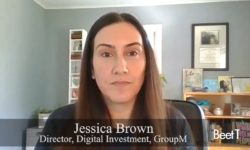CHICAGO – The emergence of connected TV has bifurcated viewing behavior along age lines, providing a neat segmenting opportunity for health and wellness brands.
But those brands will need to do more than that to avoid marketing to off-limits audience members.
That is according to healthcare media planning and buying agency Publicis Health Media.
In this video interview with Beet.TV, PHM’s VP, Media Technology Chatigny Imburgia explains how the world is changing during the COVID-19 pandemic.
CTV’s age split
Imburgia says connected TV viewing is exploding, especially as many consumers have been kept at home by quarantine and social distancing.
“You have those who may be in an older age bracket who prefer watching live, but then you also have a younger age group … they’d prefer to see content that’s custom-created for them,” she explains.
“With healthcare, what that changes for us is, we have an opportunity to reach more people and help them, whether they’re the caregiver or the actual patient.
“It’s really important for us to allocate dollars in our spend to get into CTV so that we can ensure that we’re not missing a portion of the population.”
It’s been a crazy year. So crazy that Andrea Palmer wanted to (virtually) sit down with podcast vet @ebmoss for an in-depth conversation looking at some of the ways healthcare has pivoted. Check out the latest @InsiderIntervws episode here: https://t.co/IP0gmLGCBv
— Publicis Health Media (@tweetPHM) September 28, 2020
Age concern
But Imburgia says connected TV’s handy age segmentation isn’t enough – ad buyers must use tools at their disposal to make more fine-grained buying decisions, especially in pharmaceutical, where brands are often barred from reaching out to minors.
“We have to be very careful on where we’re actually putting our messages out,” she say.
“If we can’t advertise to kids under a certain age, we have to be very cognisant of some of the new platforms that exist, more in the social media or short-form video streaming services.”
So Imburgia says she relies on partners like DoubleVerify for software that can verify the viewability, reach and audience exposed to particular ad inventory.
PHM clients include some of the world’s biggest pharmaceutical brands.
https://www.publicishealthmedia.com/perspective/patient-physician-relationships-during-covid-19/
Viral media
Early in the COVID-19 pandemic, many media buyers shied away from content about or adjacent to coronavirus, fearing negative connotation would put off audiences.
Plenty of research has since disproved that theory, and media organizations’ efforts to convince buyers of their value – both to audiences and to brands at this time – have borne some fruit.
But PHM’s Imburgia says many brands should still be wary of media missteps.
“We have some clients that really just don’t want to run against as much COVID content,” she says.
Congratulations to PHM’s Andrea Palmer for being recognized at the 2020 #MMMHallofFemme today! Several incredible women were honored for their contributions and positive impact in the health and marketing fields. pic.twitter.com/5OVfeoQHyo
— Publicis Health Media (@tweetPHM) September 22, 2020
No false dawns
A chief reason for standing on the sidelines is not raising consumers’ COVID-19 hopes unnecessarily, Imburgia says.
“Here we are, still working from home, waiting on a vaccine or a cure, whichever comes first,” she says.
“You don’t want to give false hope because we’re six months, seven months in and not much has changed, so you have to really be careful.
“Our guidance is … it’s somewhat of a value statement of where you fall but it’s very much, ‘Are you confident in your product coming to market?’
“If you’re not … you have to be very careful about where your brand stands from a values standpoint.”
This video is part of CTV Grows Up: Making a New Medium More Efficient & Effective, a Beet.TV series presented by DoubleVerify. For more videos from the series, please visit this page.







































